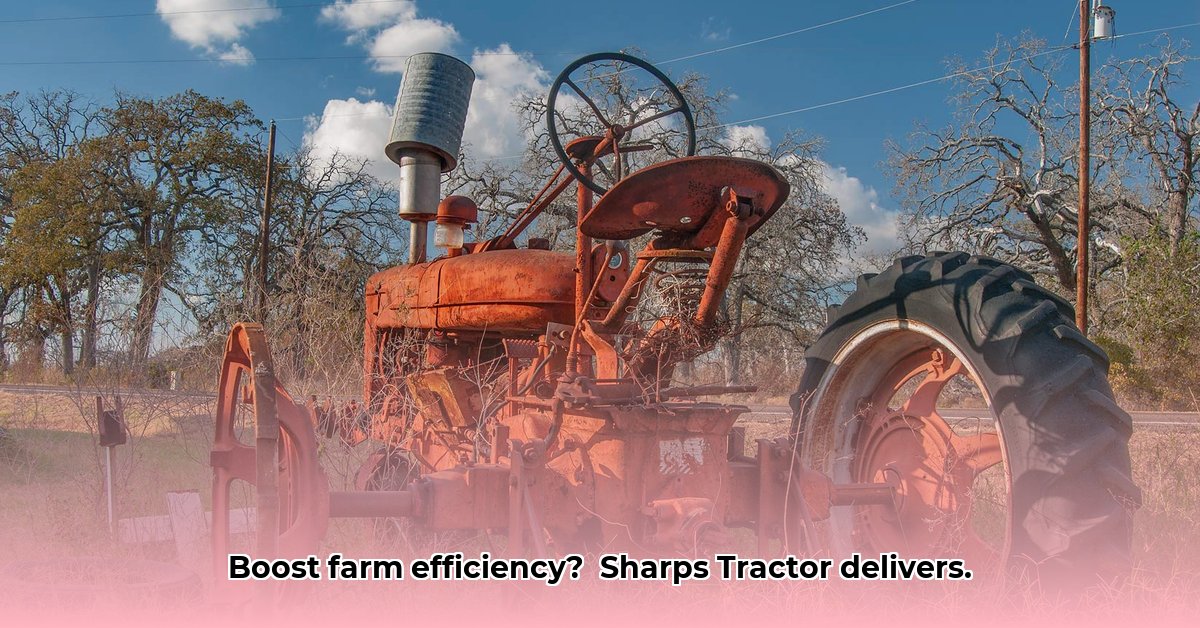
Sharps Tractor: Is it the Right Tractor for Your Farm?
Considering a Sharps tractor for your farm? This in-depth review examines key aspects to help you make an informed decision. We'll explore horsepower, technology, reliability, and compare Sharps to leading competitors like John Deere and Massey Ferguson. Ultimately, the goal is to determine if a Sharps tractor best suits your specific farming needs. Isn't maximizing your farm's efficiency the ultimate goal? For comparison, check out this review of a 39 HP Kubota.
Power and Performance: Choosing the Right Horsepower
The power you need depends entirely on your farm's workload. Light-duty tasks on a smaller farm might only need a lower horsepower model, while large-scale operations demand significantly more power for heavy plowing. Think carefully about your field size, soil type, and planned implements (plows, tillers, etc.). Hillside farming requires extra power and excellent traction. Researching Sharps' horsepower ratings across different models is crucial. Does Sharps offer models tailored to specific terrains or tasks? This information is paramount to your decision.
Features and Tech: Keeping Up with the Times
Modern farming relies heavily on technology. Features like GPS guidance, automated steering, and fuel-efficient systems can greatly enhance productivity and profitability. However, user-friendliness and compatibility with existing farm management tools are crucial. Intuitive technology translates to less frustration and higher efficiency. Carefully evaluate Sharps' technology offerings; some manufacturers are leaders, while others lag. Where does Sharps stand in this technological landscape? This directly impacts efficiency.
Reliability and Maintenance: Minimizing Downtime, Maximizing Profit
Downtime during planting season is costly. Reliability is key. What is Sharps' track record for dependability? What's the typical lifespan? What's the maintenance schedule? Are replacement parts readily available and affordable? Maintenance costs significantly impact the total cost of ownership. Easy access to authorized repair shops is also crucial. Are there conveniently located service centers near your farm? Proactive planning minimizes future problems and costly delays.
Sharps vs. the Competition: A Head-to-Head Showdown
A fair comparison against industry leaders like John Deere and Massey Ferguson crucial. While initial purchase price is a factor, consider fuel efficiency, horsepower per dollar, features, and warranty coverage. The best value isn't always the cheapest. A thorough comparison highlights Sharps' strengths and weaknesses relative to the competition. This informed comparison helps justify your investment.
User Reviews: The Voice of Experienced Farmers
User reviews offer invaluable insights. Reliable reviews from multiple sources provide a balanced perspective. Positive feedback builds confidence, while negative reviews highlight potential issues. Pay close attention to farmers' experiences with reliability, maintenance, and overall satisfaction. Remember, diverse perspectives are essential for a well-rounded understanding.
The Bottom Line: Is a Sharps Tractor Right for You?
The decision rests on carefully weighing performance, features, reliability, and cost. Don’t overspend on unnecessary technology. Consider the total cost of ownership, including fuel, maintenance, and potential repairs. A thorough analysis ensures your investment serves your farm’s needs effectively. Isn't a well-informed choice fundamental to long-term success?
How to Effectively Deduplicate and Extract Features from Multiple Articles for Content Synthesis
Creating a robust review requires synthesizing information from various sources (manufacturer websites, farmer forums, industry publications).
- Identify Core Features: List key aspects of Sharps tractors from each source.
- Deduplication and Consolidation: Remove redundant information; summarize similar points concisely.
- Comparative Analysis: Compare features with competitor brands to establish Sharps’ market position.
- Categorize and Organize: Group similar characteristics (performance, comfort, maintenance) for a logical structure.
- Verification and Fact-Checking: Cross-reference information for accuracy and reliability. This ensures the integrity of your review.
Synthesizing Your Findings: From Data to Narrative
Transform data into a compelling narrative by prioritizing relevant information, presenting a balanced perspective (both pros and cons), structuring for clarity (headings, bullet points, concise sentences), and engaging your audience with active voice and rhetorical questions. A clear, engaging narrative is crucial for reader retention.
Example Comparison Table (Hypothetical Data - Requires Actual Data from Sources)
| Feature | Sharps Tractor Model X | John Deere Model Y | Massey Ferguson Model Z |
|---|---|---|---|
| Horsepower | |||
| Fuel Efficiency | |||
| Price | |||
| GPS Guidance | |||
| Warranty (Years) |
(Note: This table requires data from your sources.)
Pros and Cons of Sharps Tractors (Requires Actual Data from Sources)
| Pros | Cons |
|---|---|
(Note: This section requires data from your sources.)